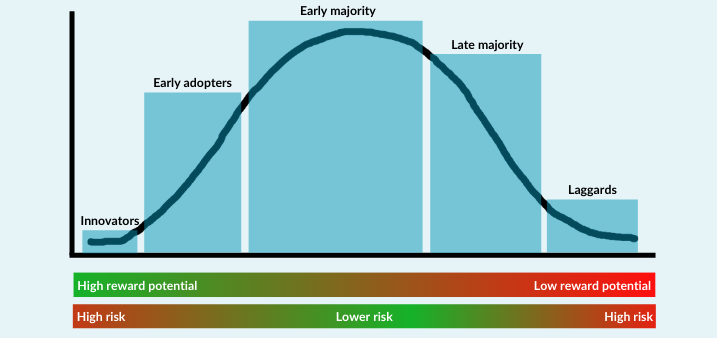It is no secret: the legal industry has a reputation for being resistant to innovation. Bound by tradition and risk-averse by nature, many attorneys simply avoid change. This is a major stumbling block for the industry in the modern fast-changing world.
But the truth is, immediate innovation may not be the right choice for every law firm.
While new technologies or business models might be critical for some firms, they may be completely unnecessary for others.
In light of the natural resistance to change within the industry, is it worthwhile to seek it out? Is it really necessary to push for innovation in the legal industry? We explore this question below.
The drivers behind law firm innovation
It is first helpful to see why there is an ongoing trend toward law firm innovation. Even more fundamental, though, is understanding what we mean by the term “innovation.”
Many think of this primarily as introducing new technology, but the concept goes beyond that. A better definition of innovation may be the introduction of something new – a product, process, or method of service – to create a competitive advantage.
There are several reasons why law firms are increasingly seeking to innovate.
Historically, there has been such consistently high demand for legal services that the legal field could afford to be more resistant to change. But there has been increasing pushback against high prices from clients since the 2007-2008 financial crisis. Firms must be more competitive in order to attract and keep new clients.
At the same time, salaries for junior attorneys have been increasing, further pressuring firms’ bottom lines. With legal technology now exploding in usage and popularity, many firms have no choice but to keep up.
The pandemic has also been a driver of innovation for firms. With remote work becoming the norm for some time, many clients may have developed a preference for video conferences and electronic signature of documents.
All of these are, at the core, a similar reason: law firms innovate because they need to compete.
Why the resistance to law firm innovation?
One of the main reasons for resistance to law firm innovation is the culture of law itself.
The law is structured around rules, regulations, and risk avoidance. These points of emphasis can lean against adoption of new technology or business models.
In addition, many firm leaders are reluctant innovators because they view the business model as simply hiring the best attorneys and paying them well.
Another challenge is a focus on billable hours, which does not incentivize time spent on innovation. How can you spend time thinking about how to do things better when you need as much of your time as possible to be billable?
Innovation also requires a monetary investment, and older partners nearing retirement are less concerned with the long-term need for innovation.
On top of all of these things, there really is a risk involved when you decide to become an early adopter. You don’t have time to waste, and some “innovations” turn out to be expensive and ineffective. Especially for a small firm, a failed experiment can have serious impacts.
Potential need for innovative business models
We just talked about the risk involved with experimentation. Now, we need to address the risk of not innovating.
You already know that the whole point of adopting these new trends is because of a need to compete. If you choose not to change, the other firms that took the risk have an opportunity to grab more of your potential clients.
A key point is that innovation does not simply refer to tech adoption. Innovation can include new business models for law firms.
One such model to explore is alternative fee arrangements. From flat-fee billing to partial contingency fees (with part of the fee contingent on a specified measure of success), there is a wide range of options here. In addition to satisfying the client, these fee arrangements could provide your firm with more payment predictability.
There are also innovations in the models of law firms themselves.
For example, some firms may be able to operate virtually, without a traditional in-person office. Others may seek to offer a higher level of client service by hiring client intake coordinators or client experience coordinators.
Reasons to embrace tech innovation
In deciding on tech innovation, firms need to ask where they would like to fall on the technology adoption lifecycle. This well-known cycle has five main stages of technology adopters: (1) innovators, (2) early adopters, (3) early majority, (4) late majority, and (5) laggards.

Innovators and early adopters are eager to be the first to discover and use new products, while laggards are deeply averse to change. A graph of the market share of these groups shows a bell curve, where 68% of market share is early and late majority, with smaller amounts in the other three categories.
Many firms are not good candidates for being innovators or early adopters since they may want their tech solutions to be market-tested first. Waiting for a little bit of evidence helps mitigate your risks.
At the same time, there can be a huge opportunity cost for laggards that stick with out-of-date technologies.
Take another look at the chart above. The closer you are to the innovator side of the curve, the bigger the potential payoff. At the same time, the farther you are from the middle, the bigger your risk. Choose what’s right for your firm, and aim to be on the front half wherever possible.
There are plenty of reasons to embrace tech innovation for your firm. Examples abound of legal tech that can transform the practice of law. Legal analytics and artificial intelligence (AI) can vastly improve legal research and law firm marketing. The client intake process can be automated. And cloud-based legal practice management software can enable remote work and quicker client responses.
In addition, much of the work formerly done by attorneys and paralegals can now be performed with legal tech. With its ability to enable more efficiency and accuracy, legal tech cannot be ignored for long.
A tendency toward tech avoidance will discourage the tech evangelists who already work for you, and it can prevent smart candidates from taking positions at your firm. These are the innovative and tech-savvy attorneys who are constantly looking for better methods of service. Many of these attorneys end up leaving the legal industry altogether in frustration.
Can your firm make the necessary investment for innovation?
A necessary ingredient for making law firm innovation work is a commitment to innovation as a business strategy.
You can even appoint a specific person, group, or department to manage legal innovation. They can also develop a plan for implementation, with constant communication and feedback while your team grows accustomed to the new systems.
Also important is building alignment within the firm behind the innovative methods.
Instead of broadcasting a new strategy and expecting immediate acceptance, this will require personal outreach.
Having someone in a leadership position get behind the innovation will also help adoption — but then target below the top team by spreading the word about the benefits of the innovation strategy.
The bottom line?
The legal industry is going to innovate and change whether you like it or not. So when everyone else has found something that solves a problem, will your firm be left behind? You don’t have to be the first to try new things, but it’s in your best interest to be open to change.
Author

After a fifteen-year legal career in business and healthcare finance litigation, Mike Robinson now crafts compelling content that explores topics around technology, litigation, and process improvements in the legal industry.
View all posts






